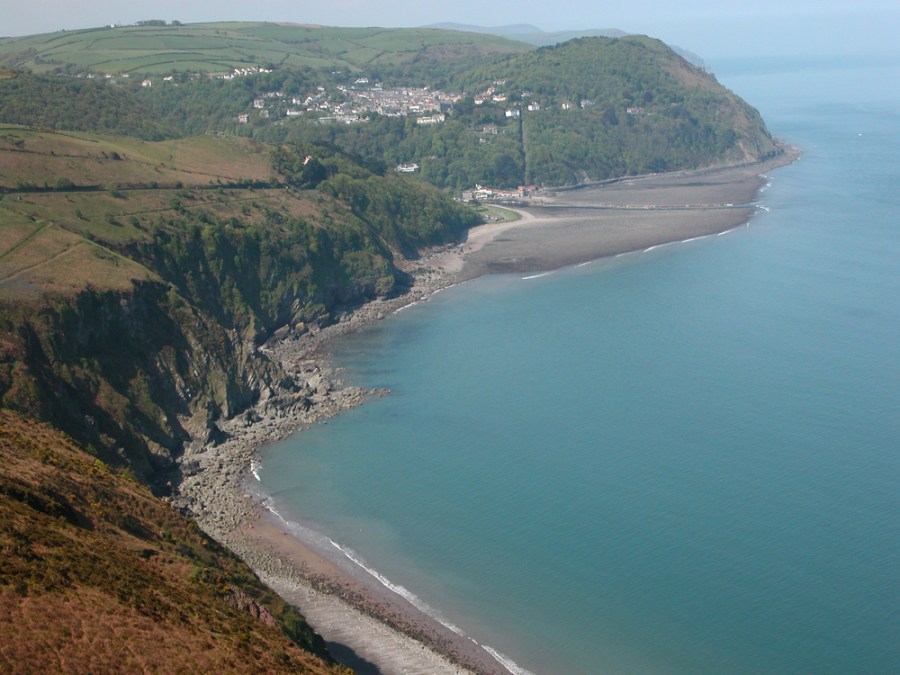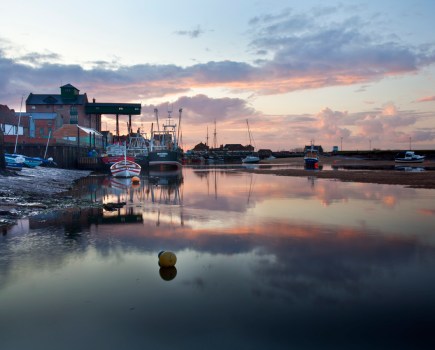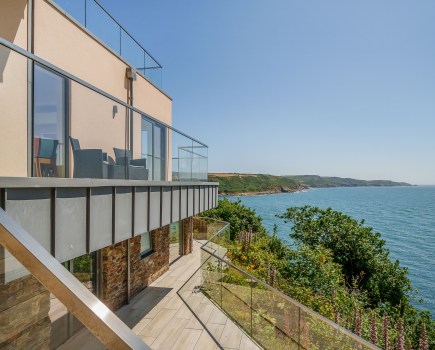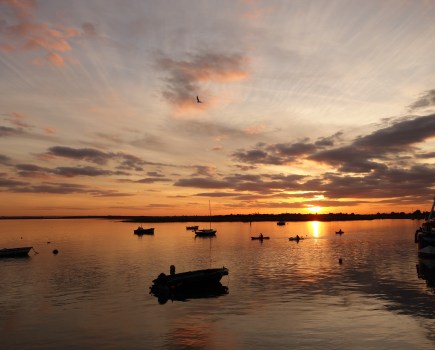With its spectacular National Park, picture-perfect towns and dramatic coastline, it’s no wonder this hard-to-reach area of Devon is so appealing to visitors. By Lesley Gillilan.
The Exmoor coast can be summed up in one word: spectacular. Straddling the border between north-east Devon and north-west Somerset, it is the highest coastline in England, with the tallest cliffs and the longest stretch of coastal woodland. Exmoor’s National Park is one of the most protected areas in the country – and one of the most romantic. With its deep river gorges, waterfalls, starry skies, small picture-perfect towns and gloriously isolated moorland landscapes, it’s a love-at-first-sight kind of place. Or at least that’s how it was for newcomer Louise Reynolds.
The first time Louise set foot on Exmoor, she was on her way to a job interview in Lynmouth. She remembers their excitement as she and her husband and two daughters drove across the moor, spotting wild ponies, ‘amazing’ wooded combes – or valleys – and rugged hills, alive with bilberry, heather and roaming deer. ‘I could see the girls really connecting with the place,’ says Louise. ‘And that was before we even reached the coast.’
Little Switzerland
When they arrived at Lynton and Lynmouth – twin seaside towns at the heart of Exmoor – she wasn’t disappointed. Lynmouth’s cute harbour village is built on the confluence of the East Lyn and West Lyn rivers and overlooks its own rocky Bristol Channel beach. Over 500ft above, Lynton’s old-fashioned streets offer dizzying clifftop views of the valley below. The two places are connected by an Alpine-style zigzag hill, or a unique water-powered funicular railway built in 1890. The Victorians affectionately called the area ‘Little Switzerland’.
Louise got the job – she is the heritage officer at the National Park’s newly rebuilt Lynmouth Pavilion; and having left their home in Suffolk, she and her family moved to Exmoor last July. ‘Everyone’s been very friendly and welcoming,’ says Louise. She is impressed by the area’s sense of community. ‘It’s like living on an island – remote but very supportive,’ she says. And she loves the wild beauty of the place: the rocks and caves, the plunging valleys and the racing tides. All this, and it’s still relatively undiscovered.
Where to buy
Lynmouth has the waterfront, but Lynton has a better choice of houses (choose between Victorian and Edwardian properties with sensational views or quaint Old Village cottages). Both places offer pretty houses, particularly in Lynton (the style is Arts and Crafts with a hint of Alpine chalet). They are affordable, too: a four-bedroom terraced house in Lynton is for sale at just under £200,000. In Lynmouth, look at houses on Tors Road, right on the East Lyn river. Porlock village, on the eastern edge of the moor, is also a popular choice.
Time out
The outdoor life is the big attraction – whether it’s hiking, cycling, canoeing, rock-climbing or horse-riding. Walkers love the area’s glorious stretch of the South West Coast Path (a highlight is Lynton’s magical Valley of the Rocks with its herd of wild goats). Beaches are not its strong point, but there are sheltered coves at Woody Bay, Lee Bay or Heddon’s Mouth (for sandy beaches head for Minehead in Somerset; for surfy beaches drive to Woolacombe in Devon). Eat out at The Culbone (01643 862259, culbonestablesinn.co.uk), a moorland restaurant, or The Oak Room (01598 753838, theoakroomlynton.co.uk). This authentic Spanish tapas restaurant is a previous winner of the North Devon’s Best Restaurant awards.
Jobs & Communting
The Exmoor coast is not an easy place to get to – or to find work. Outside of farming and tourism, there are very few jobs and it’s a long commute to anywhere. A slow section of the A39 wiggles across the moors between Barnstaple and Minehead but there’s no motorway (not even a dual-carriageway) and no railway. Trains from Barnstaple (a 40-minute drive) connect to mainline services at Taunton (another hour and 40 minutes). The 180-mile journey by car to London takes around four hours.
Schools
West Somerset operates a three-tier education system and there is a good first (primary) school in Lynton, but middle school children need to travel to nearby Dulverton. The nearest secondaries are in Minehead, Ilfracombe or Barnstaple. An excellent bus collection service is provided for commuting Exmoor kids.
Reality check
Exmoor proper doesn’t do cities, or even towns of any significant size. Nearly half the population live in Dulverton, Porlock, Lynton or Lynmouth – none of them much bigger than a village. And living in this wild and sparsely populated place requires some compromises – there are no superstores (the nearest are at Tiverton or Barnstaple), very few petrol stations, poor phone reception and little in the way of public transport – it would be hard to survive here without a car. The pay-offs include clean air, low crime, tranquil countryside and the beauty of nature.
Coming up
In such a highly protected area nothing changes much, except the demographic. Exmoor has had a tendency to attract retired residents and elderly tourists, but the region is making bids to tempt younger visitors. Two recent television ads selling the area as ‘a place for adventure’ reached six million people.
What Louise likes about Exmoor
Louise is a keen rider and Exmoor – with its miles of bridleways – is ‘horse-riding heaven’. ‘There are fantastic gentle rides through the combes,’ she says. ‘On horseback you can get closer to the wild ponies and often I don’t see a single car.’ For guided rides into the Doone Valley, try Brendon Manor Riding Stables (01598 741246, ridingonexmoor.co.uk).
Lynton is the smallest town in the country to have a full-time cinema – a 68-seater in a former Methodist chapel (01598 753397, lyntoncinema.co.uk). ‘It’s wonderful to see the latest film releases in such a tiny cinema,’ she says.
The Exmoor coast Boat Trip (01598 753207, theglenlyngorge.co.uk) from Lynmouth is ‘the best way to see the high cliffs of this spectacular coastline’. Boatman Matthew Oxenham, whose family has lived here for generations, also runs the Glen Lyn Gorge ‘Power of Water’ visitor centre with its tidal-current turbine.
Pay a visit
The Old Rectory Hotel (01598 763368, oldrectoryhotel.co.uk).
City escapees Huw and Sam have turned this Georgian rectory – next to tiny Martinhoe’s village church – into an award-winning country hotel with 11 gorgeous rooms and a great location within
a whisper of the sea. Dine on Exmoor produce, take afternoon tea in the sunny orangery or enjoy a stroll along the coast path to Woody Bay. This year’s Good Hotel Guide reckons it’s the best place to stay in Devon. B&B from £160 per night.
Who’s who
The host of visiting artists and writers who have drawn inspiration from Exmoor’s romantic landscapes include poets such as Wordsworth, Coleridge and Shelley and authors Henry Williamson (Tarka the Otter) and JM Barrie (Peter Pan).
Can you afford it?
Lynton: £278,864
Lynmouth: £236,281
Porlock: £299,493
UK: £248,864
Average house prices: [may 2014]. Source: Zoopla







